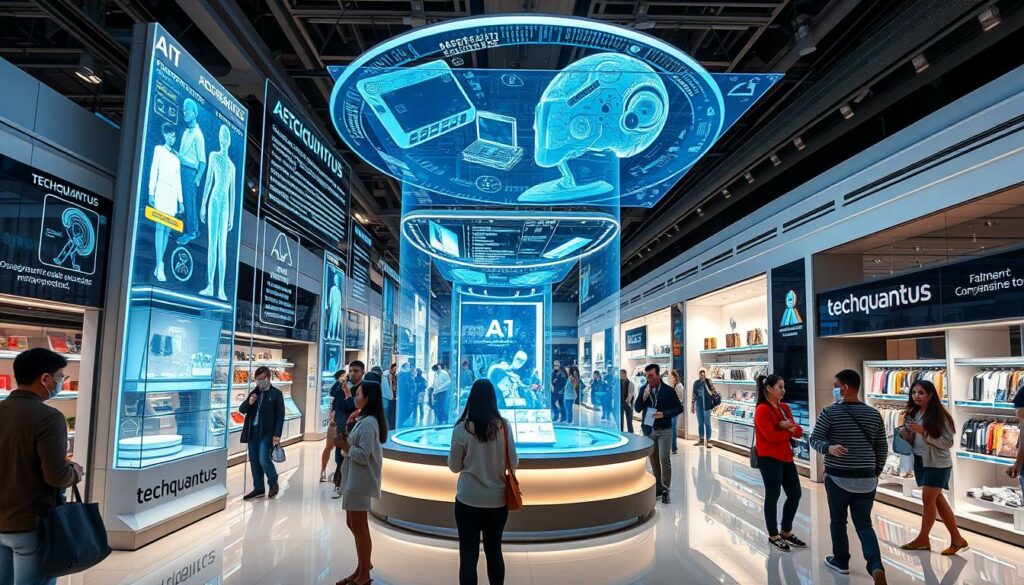Did you know the e-commerce industry is set to reach $4.1 billion by 2024? Yet, only about one-third of B2C companies have fully adopted AI in their online stores. AI-Powered Personalization can change the customer journey by offering unique interactions that match what each customer likes and needs.
AI helps businesses understand huge amounts of data to make shopping better by tailoring interactions to what customers have looked at and bought before. This move to hyper-personalized experiences is key for companies wanting to keep customers happy and loyal in a tough market.
Exploring AI marketing tools is crucial to making strong bonds with your customers. By using automation, making things more custom, and trying new ideas, you can stand out and work more efficiently. For more on how AI changes things, check out this article here.
Key Takeaways
- AI can make shopping more personal by looking at how people behave.
- Hyper-personalization builds loyalty and makes customers happier.
- Using AI in real-time helps with pricing and promotions.
- AI tools improve how we map out the customer journey.
- AI helps test and improve marketing campaigns.
- Putting the customer first is key to using AI well.
Understanding Hyper-Personalization
Hyper-personalization means making experiences unique by looking at what customers like and want. It’s more than just personalizing things a bit. It changes how companies talk to customers in real time, making them more likely to buy and stay loyal.
AI plays a big role in making hyper-personalization work. With AI, companies can look at lots of data to get to know what customers prefer. For instance, companies using AI make messages that really speak to their customers. This makes customers feel like the company gets them, which makes them more engaged.
This way of personalizing is important in many areas, making things better for customers. It helps businesses do more than just sell things. Knowing how to use hyper-personalization is key for companies that want happy and loyal customers.
For more info on new tech changing business, check out articles on cyber-physical-systems. These articles talk about new ways to make hyper-personalization even better.
Benefits of AI in Enhancing Customer Experiences
AI changes how companies talk to their customers. It’s great at looking at lots of data fast and accurately. For example, AI uses Natural Language Processing (NLP) to read through many customer reviews and social media posts. This helps businesses know what customers like, making them happier.
AI also predicts what customers will need in the future. By looking at past data, companies can plan better. This means they can stock up on what customers want and market smartly. This way, you meet and beat customer expectations, keeping them coming back.
AI helps automate customer service with chatbots and virtual assistants. This cuts down on wait times. These AI tools handle simple questions well. They let people focus on the harder stuff, making customers happier overall.
Companies using AI for customer service see big wins, like lower costs and better data insights. As AI grows, it plays a key role in making customers happy. Those who use AI now are set to do well in the future.
AI-Powered Personalization Techniques
AI personalization techniques change how businesses talk to customers. They use data to understand and group their audience. This helps tailor marketing to fit what customers want, making campaigns more effective and engaging.
Data-Driven Insights for Customer Segmentation
Data insights are key for segmenting customers. By looking at things like what people buy and what they look at online, companies can spot different groups. This lets them send ads and deals that really speak to each group, boosting sales and loyalty.
Real-Time Customer Interaction Analysis
Watching how customers interact in real-time makes personalization even better. By tracking what people do on websites or social media, companies can quickly respond to their needs. This means sending out offers and messages that are just right, making customers happier. Being able to change marketing plans quickly is key to making campaigns work best.
| Techniques | Description | Benefits |
|---|---|---|
| Behavioral Segmentation | Categorizing customers based on their activities and interactions. | Allows for targeted marketing efforts that resonate well with specific groups. |
| Predictive Analytics | Analyzing past data to anticipate future behaviors. | Enables businesses to create proactive marketing strategies. |
| Dynamic Content | Customizing website and email content based on user behavior. | Improves engagement through relevant and timely messaging. |
Leveraging Customer Journey Mapping Solutions
Understanding how your customers interact with your brand is key to making their experience better. Customer journey mapping shows these interactions visually. It helps businesses find problems and make the customer experience better. Real-time mapping technologies make it easier to change strategies based on what customers do and like.
Mapping the Customer Journey in Real-Time
Real-time mapping gives quick insights into what customers do at different points. This lets you see and understand their actions right away. You can then make changes quickly to keep customers happy. Real-time mapping can make customers more satisfied by fixing problems fast and making experiences fit what each customer wants. For more info on customer journey mapping solutions, check out the report on market trends and competition.
Integrating Omnichannel Experiences
Having a smooth omnichannel integration is key to a great customer journey. It lets customers move easily between online and offline, making their experience better. By linking these channels, businesses get a better picture of what customers like and do. Big names like Adobe Inc. and Oracle Corporation use this to offer personalized experiences. The market shows how important it is to handle both online and offline well to keep customers happy.

Implementing AI Marketing Tools
Using AI marketing tools can change how you market. These tools help you automate marketing tasks, making you more productive. They also give you deep insights into what customers like, helping you improve how you connect with them.
When you add AI tools to your marketing, you can make experiences that really speak to your audience. Predictive analytics, a key feature, lets you guess what customers might want. This means your ads will hit the mark more often. Recent studies show that using Generative AI can make marketing tasks much more efficient.
It’s important to bring in these technologies step by step. This way, you can see how they work and tweak your plans as needed. This approach encourages innovation and keeps your team from getting swamped by automation.
AI is showing its power in making customer experiences better. For example, some websites use AI to suggest content based on what you like. This shows how AI can boost customer engagement.
As AI keeps getting better, the future of marketing looks exciting. Companies are really taking to these new tools, leading to ongoing growth and innovation. For more on how AI changes user experiences, check out this resource.
Challenges in AI-Powered Personalization
AI-powered personalization can greatly improve customer experiences, but it comes with big challenges. Companies must handle data privacy concerns as people worry more about how their info is used. They need to protect user privacy with strong data management practices and follow the rules.
Adding AI to current systems is hard. Many companies struggle with managing huge amounts of data every day. This can slow down the creation of personalized offers. Without a clear plan, teams may not use AI well.
Only 54% of top executives in Asia-Pacific have a clear plan for Generative AI. This shows how tough it is to use AI’s full power.
Issues like making AI accessible and inclusive add to the problems. A big 93% of APAC business leaders say there’s a lack of training and not enough data. The cost of starting AI projects is also a big hurdle for many companies.
Yet, 80% of companies worldwide plan to spend more on Generative AI. Focusing on these challenges is key for long-term success. Companies like Samsung Electronics are now focusing on making AI-powered experiences for consumers. They need to keep up with what people want while also protecting their data.
As AI changes, knowing about these challenges helps you make smart choices about using AI for personalization. Look into the latest trends in the industry. Check out resources like how generative AI is changing creative fields.
Measuring Success with Analytics
In the world of AI-powered personalization, knowing success metrics is key. It helps you see how well your efforts are doing. By setting clear goals, you can watch things like customer happiness, how much people engage, and how many convert. These metrics are vital analytics in marketing. They help guide your plans to meet your goals.
Using strong analytics tools lets you check how you’re doing all the time. This way, you get data-driven results that make customers happier. With this method, companies can make their plans better based on what they learn in real time.
The following table shows common success metrics and why they matter:
| Success Metric | Significance |
|---|---|
| Customer Satisfaction Score | Shows how happy customers are with what the brand offers. |
| Engagement Rate | Tells you how well customers connect with your content and offers. |
| Conversion Rate | How many users do what you want them to do, showing how well personalization works. |
By keeping an eye on these important metrics, you can use data-driven insights to improve your marketing. Being proactive means you’ll get better and more effective personalized experiences for customers.
Future Trends in AI for Customer Experience
The future of AI in customer experience is exciting. New technologies are changing how businesses talk to customers. AI can quickly analyze huge amounts of data with great accuracy. This helps find personalization trends that humans might miss, leading to better interactions.
Machine learning is key in this change. It keeps getting better at spotting patterns that tell us what customers like. This lets companies offer content and services that match what customers want, making them happier. Natural Language Processing (NLP) is another big player. It looks at lots of text to find common themes and feelings in customer feedback, helping improve how companies connect with customers.
AI’s predictive analytics are also vital. They help guess what customers might do next by looking at past trends. This is useful in many areas, like healthcare, finance, and retail. For example, AI can predict disease outbreaks, help manage risks in finance, and improve how stores manage their stock.
As the future of AI in customer experience comes, handling data in real-time will get easier. This means stories can be told in a way that fits each customer’s journey. Companies can change their plans based on new information, building stronger bonds with their customers.

AI is not just making content more personal. It’s also creating new kinds of experiences with VR and AR, making things more engaging for people. By improving how it understands speech and enhances media, AI is changing how we interact with customers.
Companies that use these emerging technologies will have an edge. They’ll stay relevant in a fast-changing market. But, it’s important to make sure AI is used in a way that’s fair and ethical. This means dealing with biases and having strong rules for how data is handled.
| Technology | Benefit | Industry Application |
|---|---|---|
| Machine Learning | Identifies hidden trends and patterns | Marketing, Retail |
| Natural Language Processing | Analyzes sentiments and themes | Healthcare, Customer Support |
| Predictive Analytics | Forecasts customer behavior | Finance, Retail |
| AI in VR/AR | Enhances immersive experiences | Education, Entertainment |
| Deep Learning | Achieves high accuracy in tasks | Healthcare, Robotics |
Case Studies of Successful Implementation
Companies in many fields have seen the value of AI personalization. They use new strategies to improve customer experiences. These examples show how AI makes a big difference.
Netflix is a great example. It uses smart algorithms to understand what users like to watch. This helps Netflix make content suggestions that keep users coming back. Its success shows how AI personalization can grow a business.
Amazon is another example. It uses AI to recommend products based on what users have bought before. This makes customers happier and helps Amazon sell more.
The following table summarizes these case studies, highlighting key indicators of success in AI personalization:
| Company | Strategy | Tangible Benefits | Real-World Examples |
|---|---|---|---|
| Netflix | Content recommendation algorithms | Increased engagement and retention | Spike in subscriber numbers post-implementation |
| Amazon | Product suggestion systems | Higher sales volume | Notable increase in average order value |
These examples show the real benefits of AI personalization. By using similar methods, you can improve your customers’ experiences and grow your business.
Conclusion
Using AI for hyper-personalized customer experiences can greatly improve customer satisfaction and loyalty. By adding advanced AI tools, companies can make interactions more personal and meaningful. This summary of benefits shows that AI helps make customer interactions smoother and supports better decision-making.
When thinking about using these strategies, remember the challenges talked about in this article. It’s important to focus on ethical AI use to meet customer needs and respect their privacy. With a clear future outlook, companies using AI for personalization will stay ahead in the changing market.
Those who invest in AI for customer experience will build strong relationships and support long-term growth. For more on AI’s role in different areas, check out this useful resource. It explores how AI technology is used in various sectors.
FAQ
What is hyper-personalization in the context of customer experience?
Hyper-personalization uses AI to make experiences fit each customer’s needs and likes in real-time. This makes customers more engaged and loyal.
How does AI contribute to the personalization of marketing strategies?
AI helps businesses understand what customers want by analyzing lots of data. It then sends messages that match what customers are interested in, at the right time.
What are the benefits of integrating AI into customer journey mapping?
Using AI in customer journey mapping shows how customers interact with a brand. It helps spot problems and adjust strategies to make the experience smoother.
What challenges might businesses face when implementing AI-powered personalization?
Businesses might worry about keeping customer data safe as people get more cautious. They also might find it hard to add AI to their systems or handle a lot of data. It’s important to balance personalization with privacy to keep customers trusting them.
How can businesses measure the success of their AI personalization efforts?
Success can be checked by looking at customer happiness, how engaged they are, and how often they make purchases. Tools for analyzing data help make smart choices to improve customer experiences.
What emerging technologies are expected to shape the future of AI in customer experience?
New machine learning and AI improvements will make personalization and automation better. Companies that keep up with these changes will likely stay ahead in engaging with customers.
Can you provide examples of organizations that have successfully implemented AI-powered personalization?
Yes, looking at how some companies use AI for hyper-personalization can teach us a lot. These examples show how AI can really improve customer experiences and give us ideas to try.
Source Links
- https://solondais.fr/2024/09/08/news314999/how-ai-is-shaping-savings-strategies/
- https://www.cmswire.com/customer-experience/master-customer-experience-management-through-these-organizational-shifts/
- https://www.mdpi.com/2073-431X/13/9/225
- https://www.insidermonkey.com/blog/broadcom-inc-avgo-an-unstoppable-ai-stock-to-buy-now-1348132/
- https://www.rollingstone.com/culture/rs-gaming/madden-nfl-25-ultimate-team-is-broken-1235094070/
- https://www.albawaba.com/business/pr/ifa-2024-samsung-showcases-power-its-ai-1584639
- Top E-commerce Trends to Watch in 2025
- I Explore AI for Everyone: Understanding Its Everyday Impact
- Best AI Note-Taking Apps for Students in Switzerland
- RAG Apps: The Simple Stack to Accelerate Your Small Business
- 2025 Data Privacy Laws Update: What Small Businesses Need to Know
Related posts:
 How to Leverage AI Tools for Digital Marketing in 2024
How to Leverage AI Tools for Digital Marketing in 2024
 AI-Powered Learning: The Impact of AI on Education
AI-Powered Learning: The Impact of AI on Education
 AI in Finance: From Algorithmic Trading to Personalized Banking
AI in Finance: From Algorithmic Trading to Personalized Banking
 Ethical AI: Balancing Innovation and Responsibility
Ethical AI: Balancing Innovation and Responsibility
 Quantum Computing for Financial Modeling: What You Need to Know
Quantum Computing for Financial Modeling: What You Need to Know
 Ethical Considerations in the Development of Autonomous Robots
Ethical Considerations in the Development of Autonomous Robots
